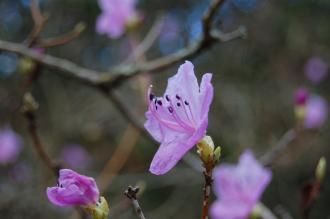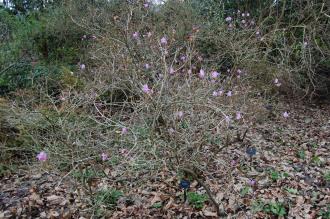
Rhododendron mucronulatum Flower (01/03/2015, Kew Gardens, London)
Position: Full sun to dappled shade
Flowering period: Early spring
Soil: Moist, well drained
Eventual Height: 2m
Eventual Spread: 2m
Hardiness: 4b, 5a, 5b, 6a, 6b, 7a, 7b, 8a, 8b
Family: Ericaceae
Rhododendron mucronulatum is a deciduous shrub with a bushy, rounded habit. Its mid green leaves elliptic with entire margins, up to 7cm long and 3.5cm broad. Its leavers turn yellow/ orange in autumn before they fall. Its pale purple flowers appear before its leaves, are funnel shaped, up to 4cm across, appear terminally or in the leaf axils singularly. Its fruit are cylindrical capsules.
Rhododendron mucronulatum, commonly known as Korean Rhododendron, is native to Japan, Korea, Mongolia, north east China and east Russia. In its native habitat it grows at the margins of deciduous forests.
The etymological root of the binomial name Rhododendron is derived from the Greek rodon ‘a rose’ and dendron ‘a tree’. Mucronulatum is derived from the Latin mucronulus meaning ‘small hook’ and atum meaning ‘possessing’.
The landscape architect may find Rhododendron mucronulatum useful as an attractive spring flowering shrub suitable for acid soils.

Rhododendron mucronulatum (01/03/2015, Kew Gardens, London)
Ecologically, Rhododendron mucronulatum flowers are attractive to pollinating insects.
The Royal Horticultural Society has given the variety Rhododendron mucronulatum ‘Cornell Pink’ their prestigious Award of Garden Merit in 1993.
Rhododendron mucronulatum prefers moist, humus rich, well-drained soils. It prefers an acid pH of soil. It dislikes wet soils.
Rhododendron mucronulatum requires little maintenance.

